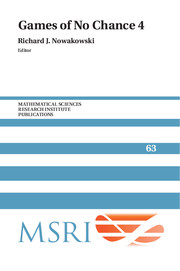Book contents
- Frontmatter
- Contents
- Preface
- Peeking at partizan misère quotients
- A survey about Solitaire Clobber
- Monte-Carlo approximation of temperature
- Retrograde analysis of Woodpush
- Narrow misère Dots-and-Boxes
- Toppling conjectures
- Harnessing the unwieldy MEX function
- The Rat Game and the Mouse Game
- A ruler regularity in hexadecimal games
- A handicap strategy for Hex
- Restrictions of m-Wythoff Nim and p-complementary Beatty sequences
- Computer analysis of Sprouts with nimbers
- Navigating the MAZE
- Evaluating territories of Go positions with capturing races
- Artificial intelligence for Bidding Hex
- Nimbers in partizan games
- Misère canonical forms of partizan games
- The structure and classification of misère quotients
- An algorithm for computing indistinguishability quotients in misére impartial combinatorial games
- Unsolved problems in combinatorial games
- Combinatorial games: selected short bibliography with a succinct gourmet introduction
Unsolved problems in combinatorial games
Published online by Cambridge University Press: 30 May 2025
- Frontmatter
- Contents
- Preface
- Peeking at partizan misère quotients
- A survey about Solitaire Clobber
- Monte-Carlo approximation of temperature
- Retrograde analysis of Woodpush
- Narrow misère Dots-and-Boxes
- Toppling conjectures
- Harnessing the unwieldy MEX function
- The Rat Game and the Mouse Game
- A ruler regularity in hexadecimal games
- A handicap strategy for Hex
- Restrictions of m-Wythoff Nim and p-complementary Beatty sequences
- Computer analysis of Sprouts with nimbers
- Navigating the MAZE
- Evaluating territories of Go positions with capturing races
- Artificial intelligence for Bidding Hex
- Nimbers in partizan games
- Misère canonical forms of partizan games
- The structure and classification of misère quotients
- An algorithm for computing indistinguishability quotients in misére impartial combinatorial games
- Unsolved problems in combinatorial games
- Combinatorial games: selected short bibliography with a succinct gourmet introduction
Summary
The numbers in parentheses are the old numbers used in each of the lists of unsolved problems given on pp. 183–189 of AMS Proc. Sympos. Appl. Math. 43 (1991), called PSAM 43 below; on pp. 475–491 of Games of No Chance, hereafter referred to as GONC; on pp. 457–473 of More Games of No Chance (MGONC); and on pp. 475–500 of Games of No Chance 3 (GONC3). Some numbers have little more than the statement of the problem if there is nothing new to be added. References [year] may be found in Fraenkel’s bibliography at the end of this volume. References [#] are at the end of this article. A useful reference for the rules and an introduction to many of the specific games mentioned below is M. Albert, R. J. Nowakowski and D. Wolfe, Lessons in Play: An Introduction to the Combinatorial Theory of Games, A. K. Peters, 2007 (LIP) or Berlekamp, Conway and Guy, Winning Ways for your Mathematical Plays, vol. 1–4, A. K. Peters, 2000–2004 (WW).
Subtraction games with finite subtraction sets are known to have periodic nim-sequences. Investigate the relationship between the subtraction set and the length and structure of the period. The same question can be asked about partizan subtraction games, in which each player is assigned an individual subtraction set. See Fraenkel and Kotzig [1987].
Information
- Type
- Chapter
- Information
- Games of No Chance 4 , pp. 279 - 308Publisher: Cambridge University PressPrint publication year: 2015
